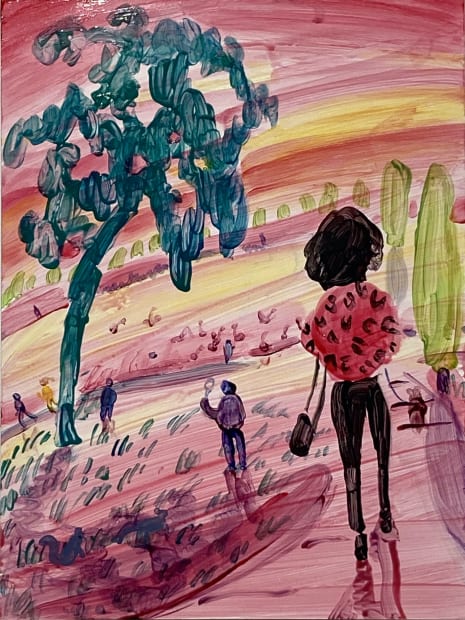-
Hilary Doyle - Inventing Eden
December 10 - 31, 2021 -
-
-
-
-
“Archaeological, mythological and historical evidence all reveal that the female religion, far from naturally fading away, was the victim of centuries of continual persecution and suppression by the advocates of the newer religions which held male deities as supreme. And from these new religions came the creation myth of Adam and Eve and the tale of the loss of Paradise.”
Merlin Stone, When God Was a Woman (1978)
This show introduces a new series of paintings depicting a contemporary Garden of Eden: the public park. Parks can be utopian in the ways they connect people with nature and others in urban spaces. Conversely, parks can harbor a sense of artificiality or eeriness, especially at night. Focusing on the conditions in which people live helps us examine the rituals, psychology and emotions of daily life. The setting of public urban parks also becomes a stage for questioning mythologies and how they have shaped our world. Several of the works in the show reinterpret historical paintings of silenced women, depicted in artworks of the past. For example, the Greek Goddess Daphne runs from Apollo’s grasp in several works or the Venus of Willendorf basks skinnydipping in primordial water.
-
Three main forms of research inspire each painting: observations, literature, and collecting fruit patterns. The work starts with mundane moments observed, often sketched or noted on daily stoller walks with the artist’s toddler in public parks. These memories are combined with research on historical paintings to make sketches. Monotypes and loose watercolors are then made from these sketches to inform paintings. Doyle’s new daily watercolor practice, and her monotypes have influenced a new minimal expressiveness in these small paintings. Brush strokes balance between abstraction, image and emotional gesture in each mark. The speed and dissolving bodies in flux represent the fluidity and fleeting intensity of real everyday life that everyone experiences.
Books that influenced these paintings include: 'Herland', a perfect feminist world created by Charlotte Perkins Gillman, 'The Heroin with 1001 Faces' by Maria Tatar, 'Societies of Peace: Matriarchies Past, Present, and Future', stories collected by Heidi Goettner-Abendroth, and 'Braiding Sweetgrass' by Robin Wall Kimerer.
-
Another important reference point is 'When God Was a Woman' by archaeologist Merlin Stone. The author compiles countless examples in ancient, neolithic and prehistoric art that all point to a time, not that long ago, where women were not just equal to men but respected members of society and celebrated and worshiped as goddesses. Her book shows how art, religion and mythology were all used as tools to remove women’s power in society and that this is a fairly recent 2,000 year old phenomenon.
These paintings utilize humor and narratives of women and mothers to question the curse of oppression that was first placed on women by the artwork of the past and still permeates into society today. Fruit patterns, often painted on women’s clothing hold many symbols: hope for a fresh start in the pandemic, the oppressive forbidden fruit myth, or how women, like fruit or flowers, are all too often underestimated, as simply beautiful.
-
-
-
-
-
Works
-
FOR HILARY DOYLE'S CV PLEASE CLICK HERE



















